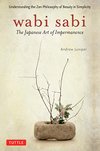
Saved by Lael Johnson and
Wabi Sabi: The Japanese Art of Impermanence

Saved by Lael Johnson and
It is an undeniable truth that much of the beauty accredited to the simple lines in Japanese design comes down to the determination to keep both art and everyday designs to a functional minimum. There has been a tendency in the West to make something beautiful and to then spoil it by fussing it up.
The patina is absolutely critical for the final finish of the piece as it makes all the difference to the visual impact. The eye is very sensitive to these subtle variations, and for a piece to be really appealing every effort must be expended to develop a patina that captures the wood’s extended history.
The old flagstones found in English cottages are a perfect example of how the uneven worn surface of the stones can complement an interior.
Mu is the thorny Zen concept not of nonexistence, as the translation of “nothingness” suggests, but rather the passing through to that which lies beyond the dualism of existence and nonexistence.
As Albert Camus said, “Man is a creature who spends his entire life trying to convince himself that his existence is not absurd.”
Music has been described as the spaces between the notes, and in art, too, the areas that are not actually used can be just as important as those that are.
When looking for wabi sabi pottery either overseas or at home the following are guidelines on what to look for: Functional rather than decorative Rough and organic feel Little to no defined design Dark, mute colors, preferably with a natural ash glaze Complexity in color and texture Naturalness and ease of use
Design criteria: Careful and constant observation of the physical balances found in nature No prescribed formulae No regular or uniform shapes Design elements balanced in a way that looks completely natural and unforced
The great American-born woodworker George Nakashima has built his work around the principle that each piece of wood has a perfect use, and it is up to the woodworker to find that use and to allow the tree to live on through his craft. His work revolves around the natural beauty of the wood, and working it in such a way as to give full play to the
... See more